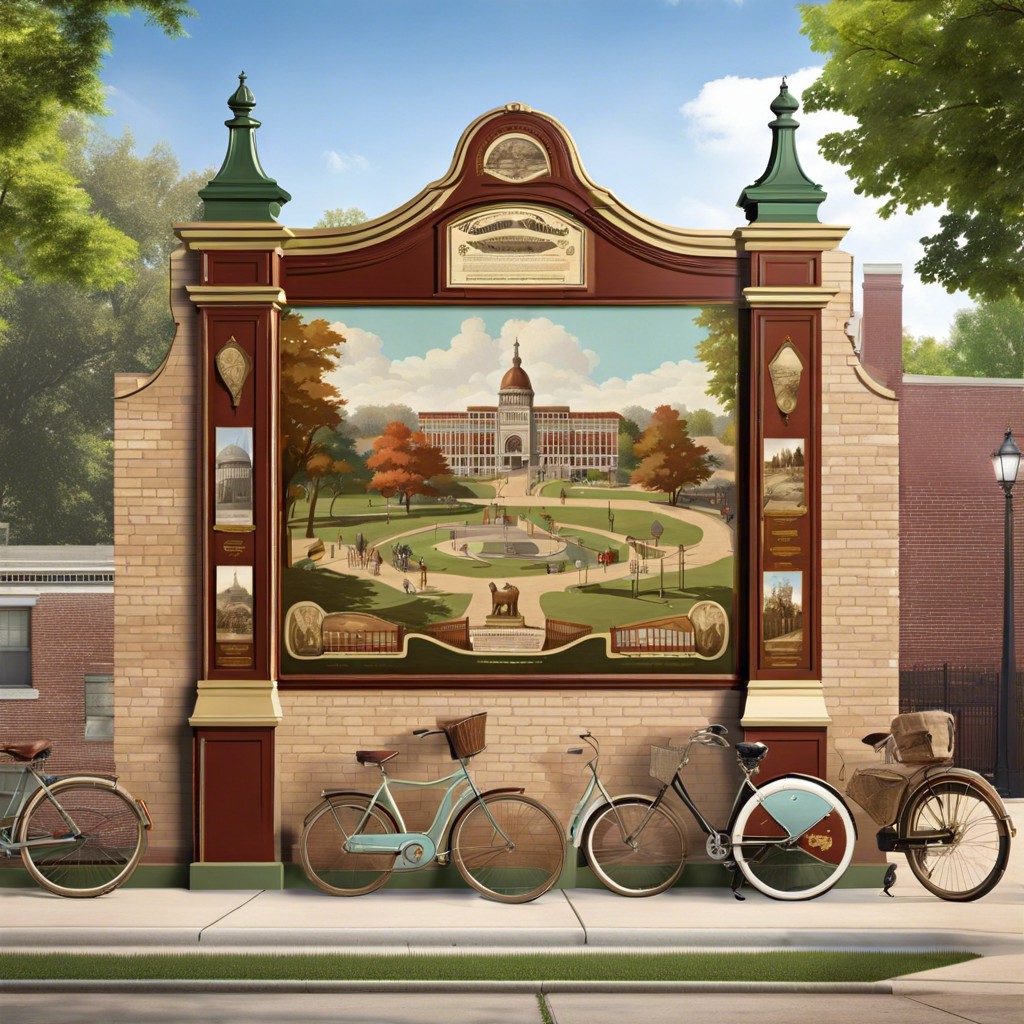Last updated on
Dive into the mesmerizing world of antique TV shows because they offer a unique glimpse into the past, shaping the landscape of modern television.
Key takeaways:
- Antique TV shows combine discovery, history, and personal stories.
- These shows have popularized antiques and sparked interest in history.
- Notable antique TV shows include “Antiques Roadshow,” “American Pickers,” and “Pawn Stars.”
- Antique TV shows have influenced the antiques market and increased demand.
- Viewers engage through social media, events, and educational outreach.
Overview of Antique TV Shows

Antique TV shows combine the thrill of discovery with the allure of historical objects, taking viewers on a journey through time. They often feature experts who evaluate items brought in by the public, providing insights into their historical significance and value. These programs tap into the universal fascination with the past, and the personal stories attached to heirlooms.
They also educate audiences about the importance of preservation and the criteria that determine an item’s worth, such as rarity, condition, and provenance. By showcasing the process of finding, evaluating, and sometimes restoring antiques, these shows serve as both entertainment and a valuable resource for amateur and seasoned collectors alike.
Popularity and Cultural Impact of Antique TV Shows

Antique TV shows have garnered a significant following, with viewers drawn to the thrill of discovering hidden treasures and learning about historical artifacts. Their widespread appeal lies in the unique blend of history, personal stories, and the suspense of valuation. Additionally, these shows have democratized the appreciation of antiques, making it accessible to a broader audience beyond collectors and enthusiasts.
Through their depiction of rare and valuable items, these programs have influenced trends in interior design and sparked a renewed interest in heritage and provenance among the general public. They often highlight the importance of preservation and the craftsmanship behind antique pieces, fostering a cultural appreciation for artifacts that might otherwise be forgotten.
Moreover, the interactive format encourages audiences to consider the potential value of their possessions, leading to a surge in attic explorations and visits to local antique shops. As a result, antique TV shows have not only entertained but also educated viewers, contributing to a collective understanding of history and appreciation for the past.
Notable Antique TV Shows
“Antiques Roadshow” stands out as a pioneering series that began in the UK and has since spawned versions in various countries, including a popular American edition. The show’s format involves members of the public presenting their personal collectibles to experts for appraisal and background discussion, blending education with the thrill of potentially uncovering hidden treasures.
“American Pickers” takes viewers on a journey across the United States with its hosts, who dig through neglected collections and properties in search of rare artifacts. The show emphasizes the ‘pickers’ aspect of the trade, focusing on the process of finding and acquiring antiques.
“Pawn Stars,” set in a family-owned pawn shop in Las Vegas, provides insights into the wheeling and dealing side of the antique business. It combines historical discussion with the art of negotiation, offering an entertaining look at the value and rarity of varied items brought in by clients.
Each of these shows has contributed to the mainstream appeal of antique collecting and has influenced viewers’ appreciation of history and the value of preserving the past.
Antiques Roadshow (1979–)
Originating in the United Kingdom, this pioneering program has become synonymous with antique television programming worldwide. Each episode features a series of local events where community members bring their possessions for appraisal. Experts in various fields of antiquities assess the items, often unveiling fascinating stories and surprising values. The show’s format encourages viewers to consider the hidden treasures in their own homes and fosters a greater appreciation for historical items.
Key aspects of the show include:
- The diversity of items appraised: from paintings and furniture to collectibles and memorabilia.
- The reveal of appraised value, which often comes with dramatic reactions from owners.
- The educational segments where specialists share historical context and tips for identifying valuable pieces.
- The “finds,” occasional rare items of significant value or with an exceptional story, that captivate audiences.
Beyond entertainment, the show has an educational aspect, promoting historical knowledge and preservation of heirlooms. It has inspired various international versions, each adapting to regional tastes in antiques and collectibles.
American Pickers (2010–)
Hosted by Mike Wolfe and Frank Fritz until Fritz’s departure in 2021, “American Pickers” showcases the pursuit of rare and valuable items hidden in the garages, basements, and barns across America.
The hosts travel extensively, unearthing pieces of history and exploring their stories. Their finds are often purchased, restored, and resold.
The show emphasizes the value of preservation and the art of negotiation, skillfully blending education with entertainment. This process enlightens viewers on identifying hidden gems and understanding the historical context of objects.
Key to the show’s charm is the connection with the object’s owners, often delving into personal histories and the provenance of items. These interactions offer a human element to collecting, celebrating the nostalgia and personal narratives associated with antiques.
“American Pickers” has also played a role in appreciating Americana, and it inspires viewers to value the past and possibly explore their entrepreneurial instincts in the antique market.
Pawn Stars (2009–)
Focusing on the family-owned Gold & Silver Pawn Shop in Las Vegas, Nevada, “Pawn Stars” provides a blend of historical education and entertainment. The series showcases a variety of items brought in by customers, from commonplace goods to rare collectibles, offering viewers an insight into the art of negotiation as well as a mini-lesson on each item’s historical significance.
- The Harrison family, comprising Richard, Rick, and Corey, along with Austin “Chumlee” Russell, appraise items, haggle over prices and share anecdotes with the audience.
- Episodes often include expert consultations to verify authenticity and determine value, providing depth and credibility to the appraisals and transactions.
- The show illustrates the pawn business’s day-to-day operations, including the management of loans and the potential risk involved with buying and selling items of questionable provenance.
- Personal dynamics among the cast and their interactions with customers add a human element to the show, making it not just about the antiques but also about the people behind the counter.
- “Pawn Stars” has had a role in educating the public about the value of historical objects and has created an appreciation for the stories objects tell.
Effect On the Antiques Market
Antique TV shows have exerted considerable influence on the market for collectibles and vintage items. They have popularly been credited with:
- Increased Demand: As viewers become captivated by featured items and their stories, interest in owning a piece of history often surges, leading to more people frequenting antique shops and auctions.
- Educational Impact: Audiences gain knowledge about historical objects, their origins, and their value, which enhances buyer sophistication and often leads to more informed purchasing decisions.
- Discovery Incentive: Individuals are encouraged to search their attics and basements for hidden treasures, hoping to uncover items that might be worthy of appraisal or sale.
- Price Fluctuations: With certain objects gaining fame on these shows, their perceived value can increase, sometimes inflating prices due to heightened demand.
- Authenticity Awareness: With expert appraisals televised, there is a heightened general awareness about the importance of authenticity and provenance, critical aspects that affect an item’s market value.
- Niche Markets: Specific collector niches benefit as previously overlooked items gain the spotlight, sparking new collector interests and communities.
These dynamics collectively underscore a symbiotic relationship between antique television programming and the ebb and flow of the antiques market at large.
Viewer Engagement and Community
Antique TV shows foster a sense of community among viewers, often inspiring avid fans to participate beyond passive watching.
Social Media Interaction: Many shows have active social media pages where fans can discuss episodes, share personal finds, and interact with show hosts and antique experts.
Fan Events and Conventions: These platforms organize events, allowing community members to meet, appraise items, and exchange knowledge in person.
Online Forums and Clubs: Dedicated online communities and clubs are born from the shared interest, where enthusiasts can discuss antiques, restoration tips, and show-related content.
Audience Participation: Some shows allow viewers to submit their items for appraisal or stories for potential inclusion in episodes.
Educational Outreach: Viewers often gain knowledge enabling them to better appreciate or start their own collections, and sometimes contribute to heritage preservation efforts.
Through these channels, antique television programming extends its reach, enriching the viewing experience and creating a ripple effect of interest in history, collecting, and appreciation of past craftsmanship.
Difference Between US and UK Antique TV Shows
UK antique TV shows often emphasize historical context and the provenance of items, reflecting a deep appreciation for heritage and storytelling. Experts on programmes such as the BBC’s “Antiques Roadshow” delve into the background of pieces, bringing out connections to social history and craftsmanship.
In contrast, US shows like “American Pickers” and “Pawn Stars” often focus on the thrill of the hunt and the art of negotiation. They capture a more entrepreneurial and entertainment-centric spirit, where the emphasis is on the deal-making process, the value of objects, and resale potential.
The presentation style also differs; UK shows tend to be more reserved and informative, whereas their US counterparts can be more dynamic and dramatized, echoing broader trends in American reality TV.
Production values can vary significantly, with the UK sticking to a more traditional format, and the US leaning towards high-production storytelling complete with elements of suspense and narrative arcs that keep viewers hooked.
Additionally, UK audiences are usually served a rich palette of regional variety, with programmes often touring the country and showcasing different locales. American shows, on the other hand, may have a broader national focus, aiming to encapsulate a diverse cross-section of American culture and history.
Restoration Features in Antique TV Shows
Restoration features provide a transformative aspect to antique TV shows, often taking center stage as they breathe new life into dilapidated items. Expert restorers apply their skill, revealing the potential hidden beneath years of neglect. This segment highlights the craftsmanship and techniques that go into preserving historical integrity while ensuring contemporary relevance.
- Demonstrating the restoration process educates viewers on the delicacy and precision required to handle valuable antiques.
- Before-and-after comparisons showcase the dramatic changes and instill an appreciation for the restorer’s work.
- Cutting-edge restoration technology juxtaposed with traditional methods illustrates the evolution of conservation practices.
- Insight into cost and value assessment offers viewers a realistic picture of the restoration market.
- Storytelling connects the audience emotionally to the items being restored, enhancing their understanding of the item’s historical and personal significance.
- Ethical considerations are discussed, such as when to restore versus when to preserve an item in its found state.
- Challenges and problem-solving moments engage viewers as experts encounter and overcome unexpected issues during the restoration process.




